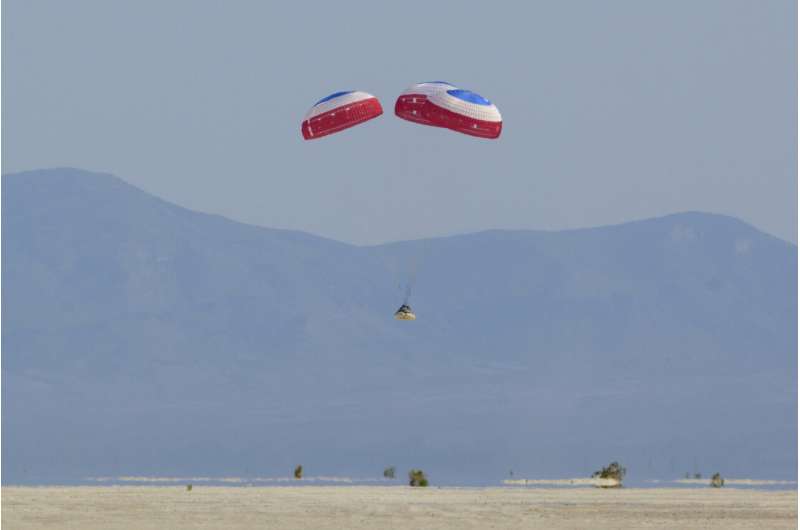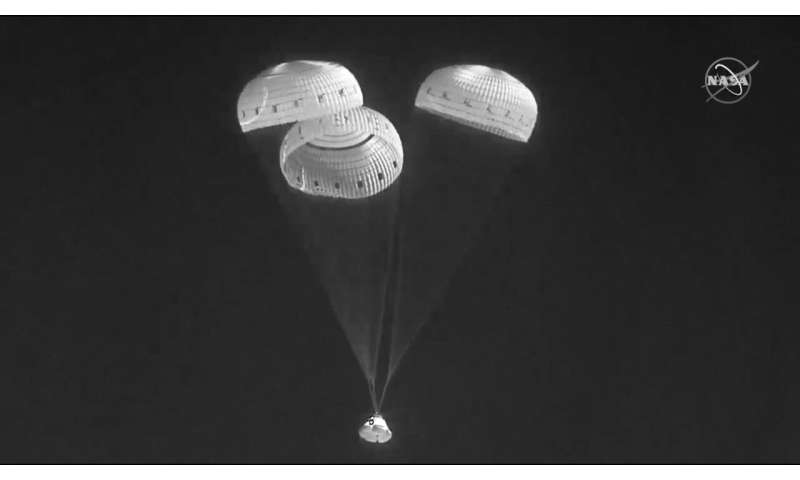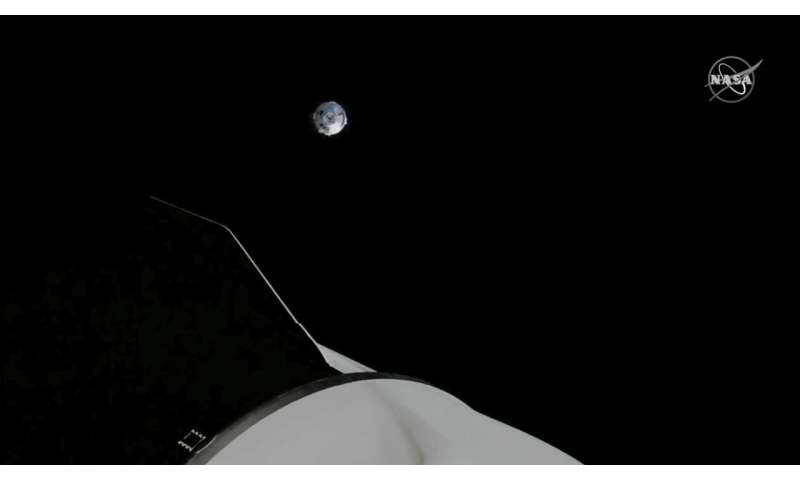Science
Boeing capsule lands back on Earth after space shakedown – Phys.org

Boeing’s crew taxi returned to Earth from the International Space Station on Wednesday, completing a repeat test flight before NASA astronauts climb aboard.
It was a quick trip back: The Starliner capsule parachuted into the New Mexico desert just four hours after leaving the orbiting lab, with airbags attached to cushion the landing. Only a mannequin was buckled in.
Aside from thruster failures and cooling system snags, Starliner appeared to clinch its high-stakes shakedown cruise, 2 1/2 years after its botched first try. Flight controllers in Houston applauded and cheered the bull’s-eye touchdown.
“It’s great to have this incredible test flight behind us,” said Steve Stich, director of NASA’s commercial crew program. He described the demo as “extremely successful,” with all objectives met.
Added Boeing’s Mark Nappi, a vice president: “On a scale of one to 10, I think I’d give it a 15.”
Based on these early results, NASA astronauts will strap in next for a trip to the space station, perhaps by year’s end. The space agency has long wanted two competing U.S. companies ferrying astronauts, for added insurance as it drastically reduced its reliance on Russia for rides to and from the space station.


Elon Musk’s SpaceX is already the established leader, launching astronauts since 2020 and even tourists. Its crew capsules splash down off the Florida coast, Boeing’s Starliner returns to the Army’s expansive and desolate White Sands Missile Range in New Mexico.
Boeing scrapped its first attempt to reach the space station in 2019, after software errors left the capsule in the wrong orbit and nearly doomed it. The company fixed the flaws and tried again last summer, but corroded valves halted the countdown. Following more repairs, Starliner finally lifted off from Cape Canaveral last Thursday and docked to the space station Friday.
Station astronauts tested Starliner’s communication and computer systems during its five days at the space station. They also unloaded hundreds of pounds (kilograms) of groceries and other supplies that flew up in the Boeing capsule, then filled it with empty air tanks and other discarded gear.
-


In this infrared image from video made available by NASA, the Boeing Starliner capsule uses parachutes as it descends to land at the White Sands Missile Range in New Mexico on Wednesday, May 25, 2022. Credit: NASA via AP
-


In this image from video made available by NASA, the Boeing Starliner capsule, upper center, leaves the International Space Station on Wedndesday, May 25, 2022. At bottom foreground is a SpaceX Dragon capsule, still docked to the station. Credit: NASA via AP
A folded U.S. flag sent up by Boeing stayed behind, to be retrieved by the first Starliner crew.
“We’re a little sad to see her go,” station astronaut Bob Hines radioed as the capsule flew away.
Along for the ride was Starliner’s test dummy—Rosie the Rocketeer, a takeoff on World War II’s Rosie the Riveter.
The repairs and do-over cost Boeing nearly $600 million.
Explore further
© 2022 The Associated Press. All rights reserved. This material may not be published, broadcast, rewritten or redistributed without permission.
Citation:
Boeing capsule lands back on Earth after space shakedown (2022, May 26)
retrieved 26 May 2022
from https://phys.org/news/2022-05-boeing-capsule-earth-space-shakedown.html
This document is subject to copyright. Apart from any fair dealing for the purpose of private study or research, no
part may be reproduced without the written permission. The content is provided for information purposes only.
Science
Marine plankton could act as alert in mass extinction event: UVic researcher – Langley Advance Times


A University of Victoria micropaleontologist found that marine plankton may act as an early alert system before a mass extinction occurs.
With help from collaborators at the University of Bristol and Harvard, Andy Fraass’ newest paper in the Nature journal shows that after an analysis of fossil records showed that plankton community structures change before a mass extinction event.
“One of the major findings of the paper was how communities respond to climate events in the past depends on the previous climate,” Fraass said in a news release. “That means that we need to spend a lot more effort understanding recent communities, prior to industrialization. We need to work out what community structure looked like before human-caused climate change, and what has happened since, to do a better job at predicting what will happen in the future.”
According to the release, the fossil record is the most complete and extensive archive of biological changes available to science and by applying advanced computational analyses to the archive, researchers were able to detail the global community structure of the oceans dating back millions of years.
A key finding of the study was that during the “early eocene climatic optimum,” a geological era with sustained high global temperatures equivalent to today’s worst case global warming scenarios, marine plankton communities moved to higher latitudes and only the most specialized plankton remained near the equator, suggesting that the tropical temperatures prevented higher amounts of biodiversity.
“Considering that three billion people live in the tropics, the lack of biodiversity at higher temperatures is not great news,” paper co-leader Adam Woodhouse said in the release.
Next, the team plans to apply similar research methods to other marine plankton groups.
Read More: Global study, UVic researcher analyze how mammals responded during pandemic
Science
Scientists Say They Have Found New Evidence Of An Unknown Planet… – 2oceansvibe News


In the new work, scientists looked at a set of trans-Neptunian objects, or TNOs, which is the technical term for those objects that sit out at the edge of the solar system, beyond Neptune
The new work looked at those objects that have their movement made unstable because they interact with the orbit of Neptune. That instability meant they were harder to understand, so typically astronomers looking at a possible Planet Nine have avoided using them in their analysis.
Researchers instead looked towards those objects and tried to understand their movements. And, Dr Bogytin claimed, the best explanation is that they result from another, undiscovered planet.
The team carried out a host of simulations to understand how those objects’ orbits were affected by a variety of things, including the giant planets around them such as Neptune, the “Galactic tide” that comes from the Milky Way, and passing stars.
The best explanation was from the model that included Planet 9, however, Dr Bogytin said. They noted that there were other explanations for the behaviour of those objects – including the suggestion that other planets once influenced their orbit, but have since been removed – but claim that the theory of Planet 9 remains the best explanation.
A better understanding of the existence or not of Planet 9 will come when the Vera C Rubin Observatory is turned on, the authors note. The observatory is currently being built in Chile, and when it is turned on it will be able to scan the sky to understand the behaviour of those distant objects.
Planet Nine is theorised to have a mass about 10 times that of Earth and orbit about 20 times farther from the Sun on average than Neptune. It may take between 10,000 and 20,000 Earth years to make one full orbit around the Sun.
You may be tempted to ask how an entire planet could ‘hide’ in our solar system when we have zooming capabilities such as the new iPhone 15 has, but consider this: If Earth was the size of a marble, the edge of our solar system would be 11 kilometres away. That’s a lot of space to hide a planet.
[source:independent]
Science
Dragonfly: NASA Just Confirmed The Most Exciting Space Mission Of Your Lifetime – Forbes


NASA has confirmed that its exciting Dragonfly mission, which will fly a drone-like craft around Saturn’s largest moon, Titan, will cost $3.35 billion and launch in July 2028.
Titan is the only other world in the solar system other than Earth that has weather and liquid on the surface. It has an atmosphere, rain, lakes, oceans, shorelines, valleys, mountain ridges, mesas and dunes—and possibly the building blocks of life itself. It’s been described as both a utopia and as deranged because of its weird chemistry.
Set to reach Titan in 2034, the Dragonfly mission will last for two years once its lander arrives on the surface. During the mission, a rotorcraft will fly to a new location every Titan day (16 Earth days) to take samples of the giant moon’s prebiotic chemistry. Here’s what else it will do:
- Search for chemical biosignatures, past or present, from water-based life to that which might use liquid hydrocarbons.
- Investigate the moon’s active methane cycle.
- Explore the prebiotic chemistry in the atmosphere and on the surface.
Spectacular Mission
“Dragonfly is a spectacular science mission with broad community interest, and we are excited to take the next steps on this mission,” said Nicky Fox, associate administrator of the Science Mission Directorate at NASA Headquarters in Washington. “Exploring Titan will push the boundaries of what we can do with rotorcraft outside of Earth.”
It comes in the wake of the Mars Helicopter, nicknamed Ingenuity, which flew 72 times between April 2021 and its final flight in January 2023 despite only being expected to make up to five experimental test flights over 30 days. It just made its final downlink of data this week.
Dense Atmosphere
However, Titan is a completely different environment to Mars. Titan has a dense atmosphere on Titan, which will make buoyancy simple. Gravity on Titan is just 14% of the Earth’s. It sees just 1% of the sunlight received by Earth.
function loadConnatixScript(document)
if (!window.cnxel)
window.cnxel = ;
window.cnxel.cmd = [];
var iframe = document.createElement(‘iframe’);
iframe.style.display = ‘none’;
iframe.onload = function()
var iframeDoc = iframe.contentWindow.document;
var script = iframeDoc.createElement(‘script’);
script.src = ‘//cd.elements.video/player.js’ + ‘?cid=’ + ’62cec241-7d09-4462-afc2-f72f8d8ef40a’;
script.setAttribute(‘defer’, ‘1’);
script.setAttribute(‘type’, ‘text/javascript’);
iframeDoc.body.appendChild(script);
;
document.head.appendChild(iframe);
loadConnatixScript(document);
(function()
function createUniqueId()
return ‘xxxxxxxx-xxxx-4xxx-yxxx-xxxxxxxxxxxx’.replace(/[xy]/g, function(c) 0x8);
return v.toString(16);
);
const randId = createUniqueId();
document.getElementsByClassName(‘fbs-cnx’)[0].setAttribute(‘id’, randId);
document.getElementById(randId).removeAttribute(‘class’);
(new Image()).src = ‘https://capi.elements.video/tr/si?token=’ + ’44f947fb-a5ce-41f1-a4fc-78dcf31c262a’ + ‘&cid=’ + ’62cec241-7d09-4462-afc2-f72f8d8ef40a’;
cnxel.cmd.push(function ()
cnxel(
playerId: ’44f947fb-a5ce-41f1-a4fc-78dcf31c262a’,
playlistId: ‘aff7f449-8e5d-4c43-8dca-16dfb7dc05b9’,
).render(randId);
);
)();
The atmosphere is 98% nitrogen and 2% methane. Its seas and lakes are not water but liquid ethane and methane. The latter is gas in Titan’s atmosphere, but on its surface, it exists as a liquid in rain, snow, lakes, and ice on its surface.
COVID-Affected
Dragonfly was a victim of the pandemic. Slated to cost $1 billion when it was selected in 2019, it was meant to launch in 2026 and arrive in 2034 after an eight-year cruise phase. However, after delays due to COVID, NASA decided to compensate for the inevitable delayed launch by funding a heavy-lift launch vehicle to massively shorten the mission’s cruise phase.
The end result is that Dragonfly will take off two years later but arrive on schedule.
Previous Visit
Dragonfly won’t be the first time a robotic probe has visited Titan. As part of NASA’s landmark Cassini mission to Saturn between 2004 and 2017, a small probe called Huygens was despatched into Titan’s clouds on January 14, 2005. The resulting timelapse movie of its 2.5 hours descent—which heralded humanity’s first-ever (and only) views of Titan’s surface—is a must-see for space fans. It landed in an area of rounded blocks of ice, but on the way down, it saw ancient dry shorelines reminiscent of Earth as well as rivers of methane.
The announcement by NASA makes July 2028 a month worth circling for space fans, with a long-duration total solar eclipse set for July 22, 2028, in Australia and New Zealand.
Wishing you clear skies and wide eyes.
-
Media8 hours ago
DJT Stock Rises. Trump Media CEO Alleges Potential Market Manipulation. – Barron's
-
Media10 hours ago
Trump Media alerts Nasdaq to potential market manipulation from 'naked' short selling of DJT stock – CNBC
-
Investment8 hours ago
Private equity gears up for potential National Football League investments – Financial Times
-



 Health22 hours ago
Health22 hours agoType 2 diabetes is not one-size-fits-all: Subtypes affect complications and treatment options – The Conversation
-
Media22 hours ago
DJT Stock Jumps. The Truth Social Owner Is Showing Stockholders How to Block Short Sellers. – Barron's
-



 Sports24 hours ago
Sports24 hours agoHow the NHL moved the Arizona Coyotes to Salt Lake City – Sportsnet.ca
-
Business22 hours ago
Tofino, Pemberton among communities opting in to B.C.'s new short-term rental restrictions – Vancouver Sun
-
Art24 hours ago
Art in Bloom returns – CTV News Winnipeg




